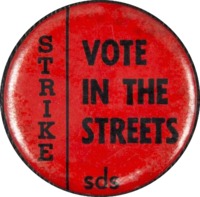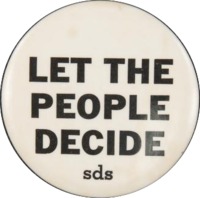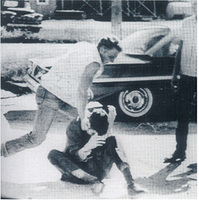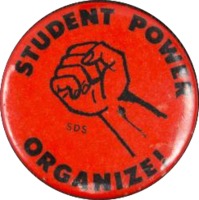Students for a Democratic Society
Students for a Democratic Society (SDS) fundamentally changed the United States’ political landscape throughout the 1960s. SDS was able to redefine how the student voice could have an impact on the political sphere. In doing so, SDS revitalized the spirit of an American democracy by promoting “participatory democracy”: a concept at the heart of their movement. Although this concept was not strictly defined, it challenged the culturally accepted notion that political life ended at the ballot. SDS deviated from this narrow view of American political life to establish a radical social change they believed was necessary. They proposed citizen engagement where people educated themselves and enabled changed around issues that were of concern to them. SDS focused on the role universities played in sparking intellectual conversation by engaging both students and faculty in political discourse and activism.
Roots of SDS
SDS was originally part of the Student League for Industrial Democracy (SLID), a social and educational organization. Due to ideological restrictions imposed on SLID by the League for Industrial Democracy, which was the parent organization SLID was financially dependent on, SLID decided to rebrand itself as an organization with greater appeal to students. As a result, Students for a Democratic Society formed with its first meeting held in 1960 at the University of Michigan in Ann Arbor, Michigan. Alan Haber became the President of SDS. He quickly sought to expand the organization’s support. However, SDS was faced with an obstacle, the League for Industrial Democracy, or LID. SDS wanted to redefine the world around them within their own terms by creating new standards for American political life. Unfortunately for SDS, LID restrained itself to the anti-communist dogma of the Cold War period. The difference between the visions of these organizations finally came to a head in June 1962 in Port Huron, Michigan.
Bringing Power Back to the People
Although several founding members of SDS came from socialist and democratic backgrounds, SDS as an organization identified itself as an educational and social action organization that brought various political groups together. SDS believed their views would revive the American democratic spirit. What made SDS unique from the Old Left is that it stressed new issues, explained in a new way by fresh faces. No longer was the defining political issue of the Left labor, and no longer was the entire political sphere systematically categorized by the power elite identified by C. Wright Mills in The Power Elite, 1956. Now, “the students were doing it; they were the resource people; they were the speakers, and to me they seemed eloquent; and they knew what they were talking about. They debated things going on around the world.” Students have a larger responsibility than merely learning in a classroom. As Alan Haber articulates in 1960, the role of the student “[also] involves the attainment of knowledge and the development of skills and habits of mind and action necessary for responsible participation in the affairs of government and society on all levels-- campus, community, state, national, international.” Students, in essence, had a duty to actively participate in society. Members of SDS (and the New Left) often grew interested in activism after either observing or participating in the Civil Rights Movement in the South, and through interaction with the Students Nonviolent Coordinating Committee (SNCC). Tom Hayden was one of these students whose interest was sparked by the sit-ins and Civil Rights Movement taking place in the South. In his “Special Report: Revolution in Mississippi,” Hayden writes an account describing the discrimination and segregation against black in McComb, Mississippi. To Hayden, this circumstance in McComb serves as a microcosm of the racial tensions across the nation and as an indicator that Americans have to take an active role in politics in order to change its social structure. Thus SNCC and the Civil Rights movement had a major impact on shaping the vision of SDS in the 1960s.
SDS defined itself in the Port Huron Statement as an organization that valued mass political participation as both an ends and a means to accomplish their goals related to democracy, civil rights, and university reforms. After the escalation of the Vietnam War in 1964 and 1965 by President Lyndon B. Johnson, SDS and the New Left rallied around the anti-war movement.SDS was one of the formative groups of the New Left, and it clarified a new political position that would redefine the traditional standards of what was accepted as political. The sociologist C. Wright Mills was the foundation upon which SDS built its ideology. Mills’ major ideas come to be part and parcel of the vision of the New Left. Decentralization is emphasized, as mass society is seen as burdensome and stifling, with “institutions [becoming] centralized and authoritarian." The New Left also took Mill’s belief that true democracy is born of and always by the people. The American “democracy” in place, the New Left argued, was not a true democracy. The masses were distanced from the actual decision-making of the state, even when these decisions affected them. As James Miller articulates in Democracy in the Streets: From Port Huron to the Siege of Chicago, Mills’s “belief that feelings of personal frustration and powerlessness ought to be connected to public issues were reiterated and developed by Hayden, becoming one basis for the characteristic assertion by the New Left (and later, by feminists) that ‘the personal’ is ‘political.”” Mills highlighted the importance of young people their ability to radically reform society.
SDS Impact
Perhaps one of the most notable achievements of SDS was its addition of the term “participatory democracy” into the popular lexicon. Participatory democracy is an amorphous concept, but it is founded upon the idea that politics should be seen positively and be inclusive to all citizens, and it should serve the interests of the people while operating in public. As Tom Hayden, the President of SDS from 1962 to 1963, told our researchers in an interview conducted for this history project in 2015, “Any time people feel deeply repressed, when they can’t enact change through politics… then they will resort to participatory democracy as the only way to express themselves." One result of participatory democracy is the creation of several decentralized groups that aimed to address specific issues through community education and cooperation, like the SDS-sponsored projects of “Students and Labor, University Reform, the Southern Project and… the Peace Research and Education Project.” This multilateral approach adopted in 1963 by SDS fits the spirit of participatory democracy: everyone should have a voice, and everyone should raise it about issues that concern or affect them.
A Wave of Activism: From Berkeley to Ann Arbor
The Free Speech Movement in Berkeley, California and SDS in Ann Arbor, Michigan had a reciprocal relationship: SDS both helped start the Free Speech Movement in 1964 and was influenced by the Free Speech Movement (FSM) later. Students in Berkeley saw the same problems that students in Ann Arbor saw with the administration of universities: after World War II, the university viewed itself as a surrogate (and supreme) parent to its students, able to provide the necessary environment to produce exemplary citizens. The university saw itself as providing security to both students and society through carefully directed education. Unfortunately, this perspective curbed the potential and the rights of students. SDS observed this on the third page of the Port Huron Statement: the curriculum of the university does not change with the pace of the world around it, and as such potential intellectual progress is sacrificed. Mario Savio, Jack Weinberg, Jackie Goldberg, and the other informal leaders of the FSM also believed that the university was overly constricting, and that it did not treat its students as full citizens of the United States. In a speech on the steps of Sproul Hall, Mario Savio “set forth the constitutional right of free speech on campus as fundamental to students being real citizens” (Rosenfeld, Subversives). Critical to note is that the one of the primary effects of the FSM at Berkeley was a strong anti-Vietnam War push. The fight for free speech at Berkeley helped form the rationale for the teach-in in Ann Arbor: students (and faculty) had the capacity and the right to voice their opinions, and the growing issue of the Vietnam War in 1964 and 1965 served as a focusing point for the enormous expansion of student activism.
Citations for this page (individual document citations are at the full document links).
James Miller (1987). Democracy is in the streets: From Port Huron to the siege of Chicago (p. 69). New York: Simon and Schuster.
Port Huron Statement of the Students for a Democratic Society, 1962. (1962, January 1). Retrieved April 14, 2015, from http://coursesa.matrix.msu.edu/~hst306/documents/huron.html
"Paul Potter Interview," pp. 4. Folder: Potter, Paul. [39]. Contemporary History Project (The New Left in Ann Arbor). Box 1; 239-J. Bentley Historical Library.
James Miller (1987). Democracy is in the streets: From Port Huron to the siege of Chicago (p. 84). New York: Simon and Schuster.
C. Wright Mills, (1960, September 1). Letter to the New Left by C. Wright Mills 1960. Retrieved April 14, 2015, from https://www.marxists.org/subject/humanism/mills-c-wright/letter-new-left.htm
Daniel Geary, "'Becoming International Again': C. Wright Mills and the Emergence of a Global New Left, 1956-1962," Journal of American History, Dec 2008, Vol. 95 Issue 3, pp. 710-736
Port Huron Statement of the Students for a Democratic Society, 1962; pp. 4. (1962, January 1). Retrieved April 14, 2015, from http://coursesa.matrix.msu.edu/~hst306/documents/huron.html
Tom Hayden (2015, March 29). Tom Hayden Discusses the Anti-War Movement [Personal interview].
James Miller (1987). Democracy is in the streets: From Port Huron to the siege of Chicago (p. 179). New York: Simon and Schuster.
Rosenfeld, S. (2012). Subversives: The FBI's war on student radicals, and Reagan's rise to power (p. 206). New York: Farrar, Straus and Giroux.
Tom Hayden, "NSA Congress- A Post Mortem," Common Sense, Vol. 4, No. 1 (October 13, 1962), p. 14; Max Papers.




